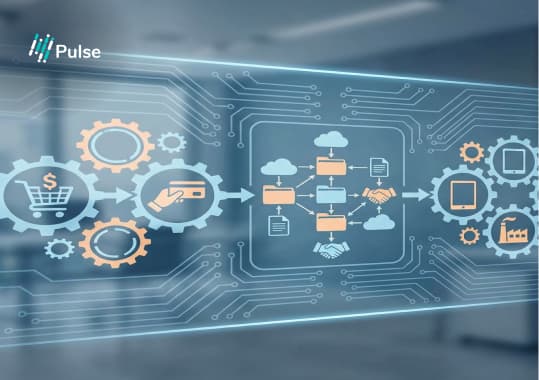Embedded lending has crossed into a new phase in 2025. What was once experimental is now becoming the core to many financial and nonfinancial platforms. For banks, lenders, and aggregators, the question has shifted: how do we build scalable, compliant, and intelligent embedded lending flows, rather than whether to do it? Below are evidence-backed trends and critical levers for success in embedded lending, along with a closer look at what the future holds.
What’s New in 2025: Deepening Intelligence and Real-Time Integration
Several patterns this year suggest that embedded lending is becoming increasingly integrated into platform ecosystems and is also evolving to be more autonomous, data-driven, and risk-aware.
Real-Time Data Ingestion and Underwriting Using Alternative Data
Many lenders are now consuming streaming financial data (bank account transactions, open banking APIs, and accounting ledgers) to assess credit risk in real time. Rather than waiting for monthly statements or static data, these models ingest financial data that offer insights into cash flow, recurring subscription payments, digital receipts, seasonal peaks, etc.
Embedded lending solutions utilising alternative data sources can reduce default rates by approximately 20-30%, as they catch early warning signs. This is forcing loan origination to support pipelines that accept varied data schemas, ingest streaming events, and feed them into machine learning engines.
Loan origination and management as Dynamic, Modular, API-First Systems
- Modern Loan Origination Systems must do more than gather applications. They need to plug into multiple data sources, support customised rule engines and underwriting configurations, allow for near-instant decisioning, and integrate seamlessly with platforms, systems, and accounting packages.
- Loan Management also needs to be unified, simplified and made accessible. Automated and timely reminders for repayments, defaults, and delinquency are integral.
Pulse is an excellent example of a leading SaaS company that has already created a Unified Lending Interface (ULI). Pulse’s Loan Origination System (LOS), Einstein aiDeal (an automated underwriting system), and Pulse’s Loan Management System (LMS) form integral parts of Pulse ULI.
Pulse LOS reduces application time to under 3 minutes with automated KYC/AML and affordability checks. Loan origination is not complete without accurate and timely underwriting. That’s where Pulse’s signature underwriting solution, Einstein aiDeal, comes in. It can process thousands of applications simultaneously, while auto-decisioning 95% of deals in under 60 seconds, with customisable criteria and minimal human involvement.
Once funds have been disbursed, Pulse LMS can help track repayments, defaults and delays. Thus, Pulse ULI offers an end-to-end solution for powerful, accurate and real-time embedded lending. To learn more about Pulse ULI, contact us today.
Embedded Partnerships, and White Label / Third Party Models
- Many platforms are choosing not to build embedded lending capabilities in-house. Third-party providers are increasingly offering plug-and-play modules for origination, loan servicing, underwriting, risk, and compliance. This reduces time to market.
- White-label lending is also gaining traction quickly, as lending is being embedded in non-financial ecosystems, including marketplaces, SaaS platforms, and procurement tools. Pulse offers seamless white labelling across its solutions, including Pulse ULI, thus creating a seamless user journey and flexibility for banks, lenders, and brokers.
Architecture and Tech Stack Imperatives
To succeed in embedded lending in 2025, advanced players are building or adopting tech stacks with the following properties:
- API-first Loan origination and management: Fully modular systems, so that any platform can integrate application intake, underwriting, disbursement, servicing, and reporting via APIs. No archaic or legacy models.
- Event-driven, real-time pipelines: Data ingestion, decision-making, and monitoring occur with minimal latency. Systems must handle streaming data and trigger workflow alerts. For example, Pulse’s DebtorIQ helps automate and streamline the entire accounts receivable process.
Use Case: While using Pulse’s DebtorIQ, “if debtor X’s invoices are unpaid for X days, flag for intervention. - Dynamic underwriting and risk models: Models that update with fresh data and offer flexible criteria. For example, the use of machine learning to catalyse automation and speed in underwriting. (like Pulse’s Einstein aiDeal).
- Explainability, auditability, human-in-the-loop capability: Even when automating decisions, protective measures must be in place. Reasons for denials or pricing adjustments and the ability for human override.
- Scalable compliance and regulation layers: KYC / identity checks, AML, fraud detection, and data privacy must be embedded. Systems should support multi-jurisdiction data residency, regulatory reporting, etc.
Risks, Trade-offs and What Advanced Players Are Monitoring
Even as the embedded lending space advances, there are delicate trade-offs and concerns to be aware of.
- Model risk and bias: As above, more complexity in data doesn’t automatically reduce risk. If historical datasets are biased, ML models can inadvertently amplify risk or misprice.
- Regulatory shocks/compliance cost risk: In some jurisdictions, regulators are introducing constraints for AI in finance. For example, explainability and transparency. Non-compliance could result in fines or even market exclusion.
- Operational complexity and technical debt: Integrating multiple external data sources, maintaining real-time pipelines, supporting various product variants, or managing legal and compliance costs across different geographies can significantly amplify operational burdens and costs. If one builds too quickly without a strong architectural foundation, it can prove to be fragile and problematic in the long run.
- Credit risk under volatile macroeconomic conditions: Since many embedded offerings target small businesses or thin-file borrowers (with limited financial buffers), macroeconomic shocks such as inflation, supply chain disruptions, or interest rate hikes can trigger a cascade of defaults. Risk models must stress test for scenario volatility.
- Customer/platform trust: There must be transparency in terms of fees and consequences. Hidden fees or opaque underwriting damage reputation quickly. Platforms embedding credit must manage reputational risk.
What to Watch Through 2026–2027
What we see on the horizon for building from 2025:
- Movement from BNPL and point-of-sale consumer credit to more embedded financing for SMEs, especially via accounting platforms and supply chain tools.
- The total addressable market (TAM) for embedded finance is estimated at $185 billion, but current penetration is only around $32 billion, indicating significant room for growth.
- Greater deployment of LLMs and generative AI not just for decisioning, but for customer counsel, distress detection, policy compliance, and system-wide anomaly detection.
- Growth in dynamic pricing and usage-based lending contracts: repayment tied to revenue flows, dynamic interest/fees adjusting based on performance, and early warning triggers for modification.
- Cross-border embedded lending with localised contracts, regulatory compliance, and multicurrency flows. This requires robust legal tech, contract management, and risk reserves.
Conclusion
Embedded lending in 2025 is crossing the threshold: from novelty to infrastructure. For advanced actors, success is no longer about simply embedding credit; it’s about doing so effectively. This involves integrating robust loan origination, underwriting, and management solutions, deploying AI responsibly, building flexible product architectures, and mastering operational complexity and regulatory compliance. Partnering with established SaaS companies like Pulse could prove to be a boon, since users can leverage full functionality immediately with zero upfront cost and easy API integration.
The paths ahead favour those who treat embedded lending not just as a marketing or distribution strategy, but as a full-stack engineering, risk, and product challenge. For those who get it right, the rewards are scale, lower acquisition cost, stronger platform lock-in, and the ability to reach previously underserved markets with risk-adjusted returns.
Related Blogs


